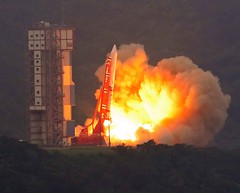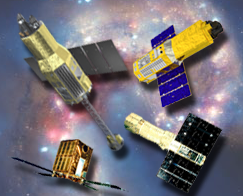NASA Telescope Launched on Japanese Space Observatory

A pioneering X-ray detector, developed jointly by NASA's Goddard Space Flight Center, Greenbelt, Md., and the Institute of Space and Astronautical Science (ISAS) of the Japan Aerospace Exploration Agency (JAXA) was successfully launched on a major new space observatory.
The high-resolution X-ray Spectrometer (XRS) was launched on board the Suzaku space observatory at 11:30 p.m. EDT, July 9 (12:30 p.m., July 10 local time) from Uchinoura Space Center in southern Japan.
The highly anticipated Suzaku mission complements NASA's Chandra X-ray Observatory and the European Space Agency's XMM-Newton mission. The observatories support the study of exotic objects and regions in space that radiate predominantly in X-rays. Suzaku is a mythical, divine bird symbolizing renewal. It was previously called Astro-E2.
Key targets for Suzaku include black holes; the million-degree gas from star explosions, which is filled with newly created elements such as oxygen and calcium; and the optically invisible gas between stars and galaxies, which comprises most of the ordinary mass in the universe.
“Suzaku will fill a vital gap in our understanding of the X-ray universe,” said Goddard's Dr. Richard Kelley, principal investigator for the U.S. contribution.
Along with the XRS on Suzaku are four X-ray Imaging Spectrometer (XIS) instruments developed in collaboration among Japanese institutions and the Massachusetts Institute of Technology. The Hard X-Ray Detector (HXD), built by the University of Tokyo, ISAS and other Japanese institutions is also on board.
The XRS and XIS instruments will analyze X-ray photons focused by individual telescopes. They were built at Goddard by a team led by Dr. Peter Serlemitsos, in cooperation with Nagoya University and other institutions in Japan. The HXD uses a tested yet improved technology.
Suzaku launched on an M-V rocket and will attain a near-Earth, circular orbit at approximately 560 kilometers (345 miles). The observatory's expected mission lifetime is five years. Suzaku is the fifth in a series of Japanese satellites devoted to studying celestial X-ray sources.



